Jump to:
Rocking Bantu knots is a time-honored tradition for African women, and now this culturally significant protective hairstyle has taken on a new level of popularity. Learn about Bantu knots and how to style them below.
Considering Bantu Knots?
Bantu knots are one of the most recognizable protective hairstyles out there and they’re becoming more and more popular as women look for natural hairstyles that won’t damage or break the hair.
You can’t miss these tribal knots – they’re twisted coils that rise up from the head like the points of a crown.
These “knots” are not really knots at all, though they appear that way. Instead, Bantu knots are tightly twisted sections of hair that use the natural grip and coarse texture of African hair types as the anchor that holds the style in place.
They can be done on finer-textured hair, but a few tweaks are required to really help the style hold without the grip of natural coily or kinky hair.
Whether you know them as Bantu knots, Zulu knots, Nubian knots, or chiney bumps (if you’re in Jamaica), it all refers to this traditional protective hairstyle for women. And that’s what our style guide today is all about – the beauty and versatility of Bantu knots!
Read Next: Types of Braids
Types of Bantu Knots
Let’s start by taking a look at some examples of Zulu knots on different hair types and a few unique ways to style them. We’ll show you how to style each one, then cover some of the frequently asked questions about this hairstyle. Finally, we’ll share the most helpful expert tips for creating beautiful Bantu knots that hold.
Wound-Up Natural Bantu Knots
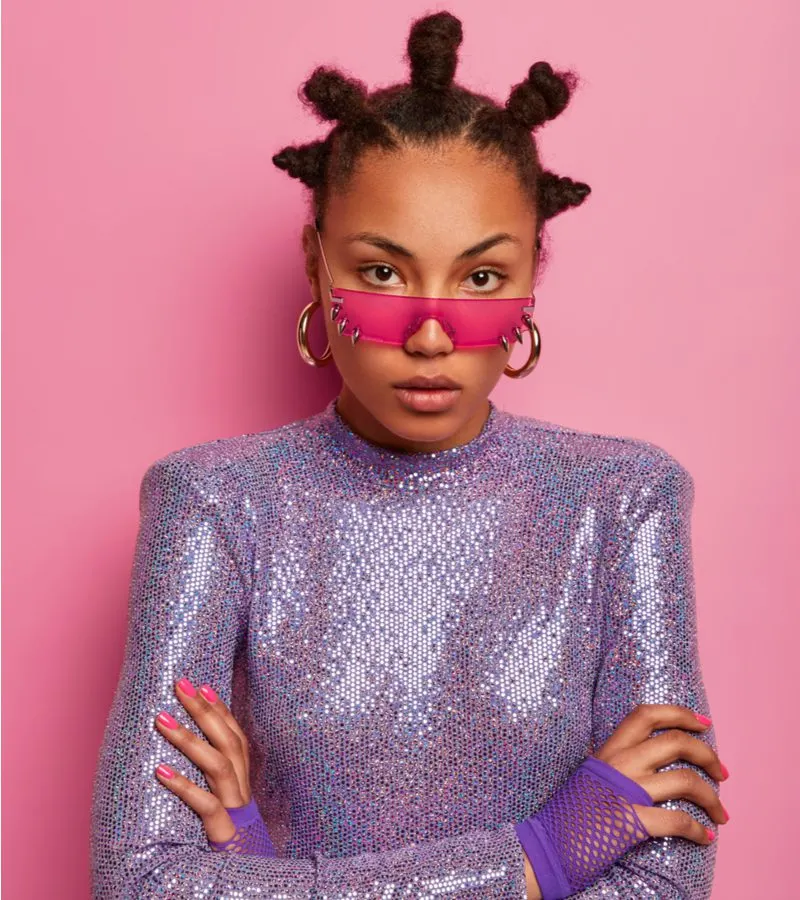
Wayhome Studio/Shutterstock
When you take the time to create clean part lines and properly moisturize your hair, the result is perfectly polished Bantu knots. Being mindful of the areas where your hair is thickest will help you create symmetrical, balanced knots that don’t vary too much in size.
Keep things natural by using just enough gel or curl cream to sculpt and hold your hair in the knots. A little frizz is okay!
How to Style
Style natural-looking knots by starting with a good moisturizer and a product with a little hold (gel or curl cream). Some women find that applying moisturizing products in the shower works best and better absorbs into the hair.
Give it a try with a good leave-in conditioner, curl cream, and even gloss applied to your hair after shampooing. Allow it to air dry for a few minutes to ensure it’s not soaking wet.
Use a rattail comb to create precise part lines all over your head in the pattern you want and secure them temporarily with small hair clips. Here, the part is started with a horizontal line across the center of the head.
Then, angled lines are traced with the tail of the comb from the center line to the front hairline. This unique parting is perfect if you don’t like the way a traditional middle part looks on you.
Unclip the center front section first. Dip your fingers into your curl cream to make it easier to hold and work with each section.
Twist the section in one direction until it forms a coil. Keep twisting until the coil wraps around itself and forms a tight spiral. Use the tail of your comb to neatly tuck the ends of the knot under at the base.
You can add a bobby pin to better secure it, especially if you plan on wearing your knots for a few days. Repeat this process for each clipped and parted section to create a natural, protective Bantu knot style!
Bantu-Inspired Twin Top Knots
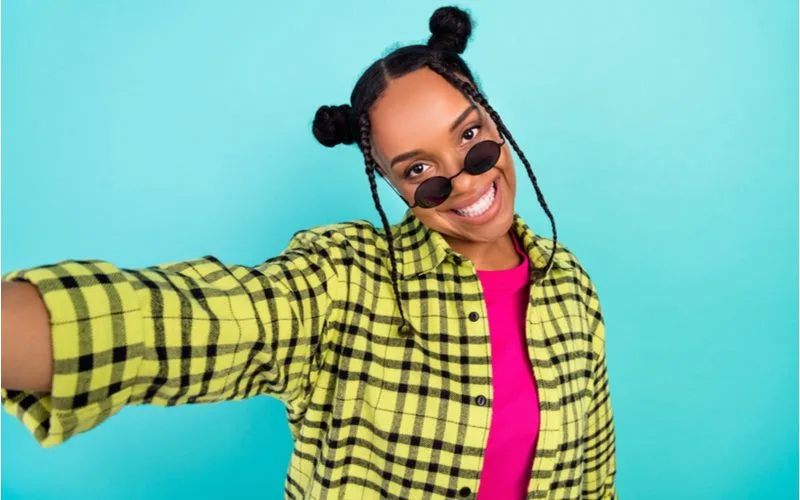
Roman Samborskyi/Shutterstock
Here’s a fun twist on this time-honored tribal hairstyle! For a quicker option that won’t require as much time to style, try twin Bantu-inspired top knots.
These knots are wrapped and twisted similarly, but here, they’re held in place with elastics and pins. The face-framing braids make this a more flattering style for many face shapes.
How to Style
To create these Zulu top knots, create a middle part with a rattail comb so it’s precise. Use the tail of the comb to trace another part line about an inch or two from the front hairline to just behind the ears. Twist this section and clip it in place with a small hair clip for now.
This front section will become your face-framing braids. Apply the medium-hold gel or curl cream of your choice to the rest of your hair. Add a little gloss or serum if you want some shine in your finished style. Brush one side upward and gather it into a ponytail.
Make sure the hair is smooth without bumps or tangles before securing with an elastic. Repeat on the other side. Begin twisting one ponytail until it forms a coil and starts to twist around the base of the ponytail.
Continue twisting until the ponytail is wound into a spiral knot. Secure with another elastic at the base and bobby pins if you need extra stability. Repeat on the other side.
Finish the style by unclipping the smaller front section. Divide the section in the middle, do a quick 3-strand braid or two-strand twist, then secure it with a small elastic. Repeat on the other half of the front section. You’re done!
Traditional Bantu Knots
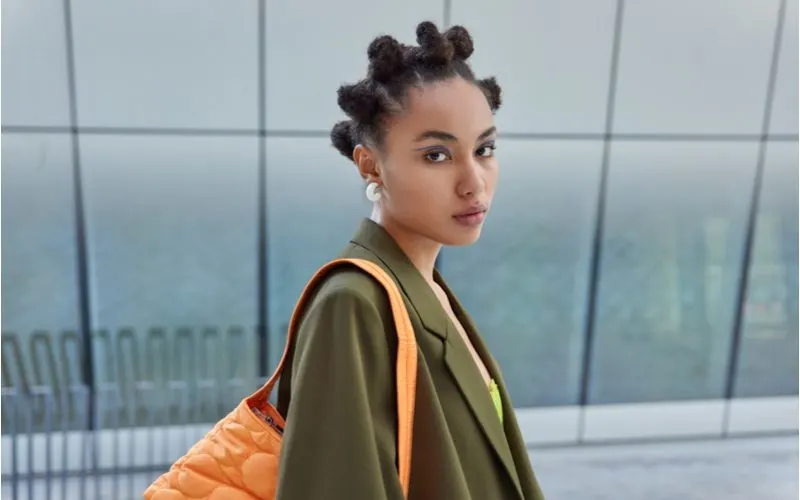
Wayhome Studio/Shutterstock
Traditional Bantu, Zulu, or Nubian knots are done on textured, coarse natural hair. The texture and volume of the coarse hair is what supports the style and gives it fullness.
In this basic version of the traditional style, the knots are created with uniformly-sized sections created with precise parts all over the head. The resulting look is similar to a crown when viewed from the front – you’re going to feel like royalty wearing these tribal knots!
How to Style
Style traditional Bantu or Zulu knots by starting with clean, moisturized hair. Work the curl cream of your choice in to help hold the style, define curls, and minimize frizz. Use the tail of a rattail comb to create clean sections and parts across your head.
Here, a horizontal line is drawn across the head instead of a vertical middle part. Draw straight lines from the horizontal center line toward the front hairline. Clip each new section as you go.
Repeat the parting process for the back, drawing straight lines from the central part down to the neckline. You should have even, uniform sections all clipped in place when you’re done.
Dip your fingers into a little of your curl cream and begin twisting an unclipped section from the front. Twist in one direction until the section becomes a coil that spirals in on itself.
Twist until it’s tightly coiled, then tuck the ends underneath the knot and pin with a bobby pin if desired. Repeat the twisting and securing process for each section. Finish with a gloss spray for a little shine boost and you’re done!
Glossy Bantu Knots for Fine Hair
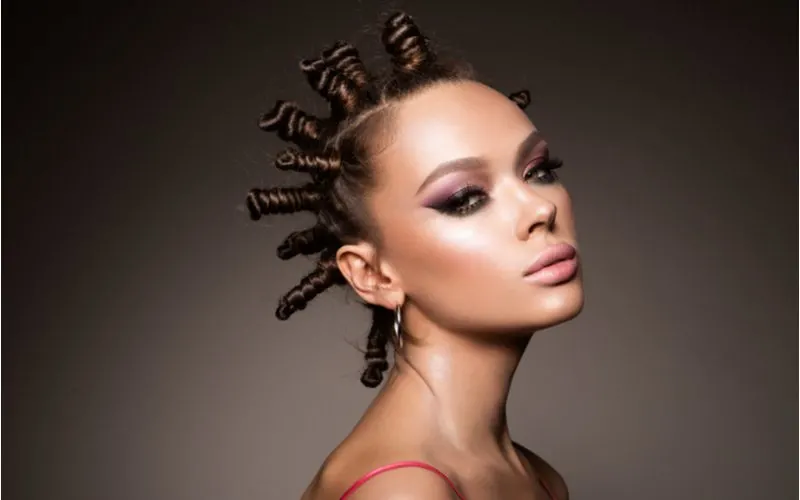
Korakova/Shutterstock
Women with fine hair may shy away from styles like Bantu or Zulu knots because these styles are designed for coarser hair with lots of texture and volume.
And the internet has spoken up about white women sporting Bantu knots in the past, calling it cultural appropriation of a traditionally African hairstyle. But Bantu knots can be a pretty and protective style for fine-haired women to either wear out or overnight for next-day curls.
Here, the Bantu knots are wound upward to create small, skinny coils that create some nice height.
The tight coils are perfect for creating next-day heatless curls, too. This is a great style for women with round or square faces as it gives the face a more elongated appearance.
How to Style
You can definitely style Bantu knots in fine hair with a few tweaks. The key is minimizing frizz and introducing a little extra grip and hold with a few products. For fine hair, gel may be too heavy and weigh the hair down.
Start with clean, damp hair and work some curl-enhancing mousse – about a silver dollar-sized amount – into your hair from root to tip.
Top it off with a little hair serum to eliminate frizz and give your hair a nice shine. Use a rattail comb to create a triangular part pattern all over your head. Start with a horizontal line across the center of your head and clip the back section up.
Use the tail of the comb to draw triangle shapes from the horizontal line up to the front hairline. Clip each triangle section with a small hair clip as you go. Unclip the back and repeat the process, clipping each triangular section as you work
Now you’re ready to twist! Starting with one of the front sections, comb through it and begin twisting it in one direction until it forms a coil. Keep twisting the coil until it spirals around the base to form a knot. As you reach the end of the coil, bring it toward the base and tuck the ends underneath.
Use the tail of the comb to help securely tuck the ends. Since fine hair won’t hold or grip as well as coarse, textured hair, you will need to use a bobby pin or two to secure each knot.
Repeat for every section, twisting, coiling, and pinning in place. If you’re doing the style for heatless curls, remove the pins in the morning (or once your hair is fully dry) and unravel the twists to reveal big, voluminous curls!
Half-Up Bantu Knots
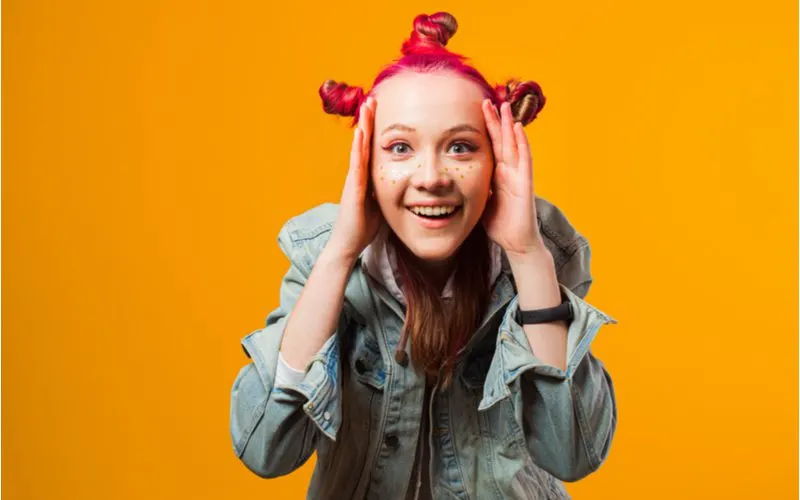
Oksana Shufrych/Shutterstock
For a cool twist on the traditional style, try styling only the top half into Bantu knots! This funky take on the style leaves the bottom half down and loose.
So you can create the texture of your choice to frame the style – here, straight hair is shown, but we think it would look amazing with soft waves or bouncy curls on the bottom half.
How to Style
Style half-up Bantu knots in fine hair as shown with a little lightweight mousse in the hair while it’s damp. Then, separate the top half from the bottom and clip or secure the bottom. Divide the top section into the number of sections/knots you want (3 shown here).
Use a rattail comb to make the part lines clean and precise. Use your pinky finger to create irregular, casual part lines. Clip each section, leaving the last one loose.
Begin by twisting the hair in the section in one direction until it starts coiling back in on itself. Continue twisting and wrapping the coil tightly until it feels secure, then tuck the ends under the knot.
Repeat for the remaining sections. Spray with a little hairspray and tuck a few bobby pins in to better hold the style. Unclip the bottom section and wear your natural texture or blow dry and use a flat iron, curling iron, or wave iron to create a little texture in the bottom half.
Frequently Asked Questions
If you’ve got burning questions, we’ve got answers. Here are some of the most common questions people have about Bantu, Zulu, or Nubian knots.
Are Bantu knots bad for your hair?
Bantu or Zulu knots are a protective hairstyle, meaning they will protect, not damage, your hair when done properly. It’s possible to damage your hair with Bantu knots by twisting them too tightly.
So make sure you’re only twisting until the hair begins to coil when you do this hairstyle. If you feel the knots tugging on your scalp or creating too much tension, take them down and wait a few days before re-twisting the knots a bit looser than before.
What do Bantu knots signify?
Bantu, Zulu, or Nubian knots are traditional African tribal hairstyles for women. These styles were originally used to signify that a woman belonged to a certain community or group – they were a symbol of sisterhood and community.
The first reports of Bantu knots were as far back as the Middle Bronze Age – 2000 BC. Bantu-speaking tribes in West Africa were the original wearers of this protective hairstyle. As the tribe migrated, the style spread throughout Africa. Today, we see the style worldwide.
How long will Bantu knots last?
Bantu or Zulu knots will last up to 2 weeks, depending on how tightly they are twisted and what products you use to hold the knots in place. With curl cream or gel with adequate hold and frizz-minimizing power, you can get the full 2 weeks of wear out of this hairstyle.
Some women prefer wearing this hairstyle for a shorter time period, as little as overnight as a method to create a knot-out or heatless curls. It’s up to you, so leave your knots in overnight or up to 2 weeks!
Can anyone wear Bantu knots?
Anyone can wear this hairstyle, including people with hanging braid hairstyles or thin dreads. You can’t wear Bantu knots with flat braids (braids that are attached to the head instead of hanging). Thick dreadlocks can also prevent the proper winding technique to create these knots.
In terms of cultural appropriation, the decision to wear Bantu knots as a non-African person is purely up to you.
If you don’t have African heritage and plan to wear this style, do some research on the tribal history of this style and what it signifies for descendants. For many, this hairstyle is more than just a hairstyle – it’s an honored tradition. Make your decision based on your research.
Expert Tips for Perfect Bantu Knots
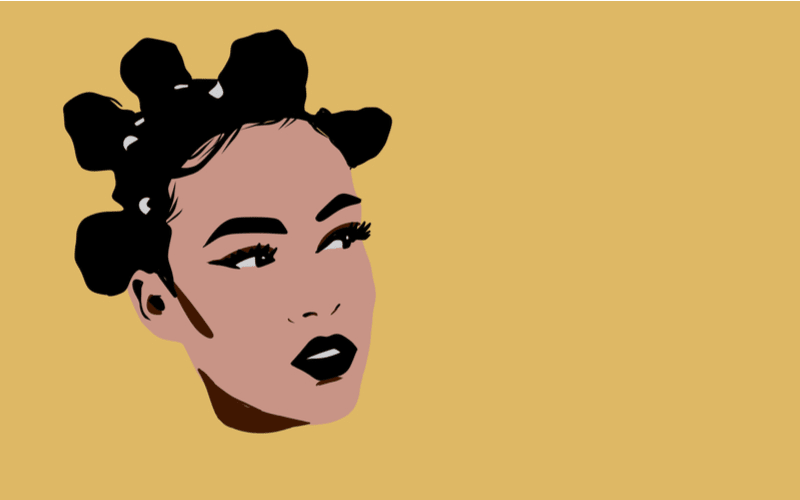
Deeworxdesigns/Shutterstock
Want to style the perfect Bantu or Zulu knots? Knot a problem! You’ll love your results so much more when you work these tips into your routine.
- Keep a spray bottle around while you style Bantu knots. This will help you ensure your hair doesn’t dry out while you work. A continuous spray bottle will ensure you keep the sections evenly wet without soaking one part while another stays dry.
- Use the tail of a rattail comb for perfectly tucked ends. Finishing Bantu or Zulu knots is often one of the areas beginners get hung up on. It’s easy to finish knots when you use the tail end of a rattail comb to tuck the ends! While pinching the very ends of your knot after wrapping, hold them at the base of your knot and push them under the base with the tip of the comb.
- Apply your hair products in the shower for better absorption. Natural hair experts recommend experimenting with product application in the shower to improve your hair’s absorption. Moisturized, defined hair creates the best Bantu knots! Try shampooing and conditioning as normal, then work in a leave-in conditioner followed by the curl cream of your choice. You can even top it off with a little gloss to seal your ends – all in the shower!
- Keep some bobby pins on hand. Your hair may hold Zulu knots without a problem, but if you plan to wear the style long-term (up to 2 weeks), you may need to supplement the stability with a few bobby pins. Tucking a pin into the base will keep it from unraveling before you’re ready to take the knots down.
Creating Bantu, Zulu, or Nubian knots is easy! You just need the right twisting technique and the right products to create hold, definition, and eliminate frizz. With this protective hairstyle, your locks will be gently stretched, protected from damage, and styled without heat or chemical processing.
When you take your knots down, you’ll have a full knot-out (similar to a twist-out) with beautifully voluminous, uniform curls. And since you can wear this style for up to 2 weeks, we foresee your hair routine getting a lot easier once you’ve mastered this style.
